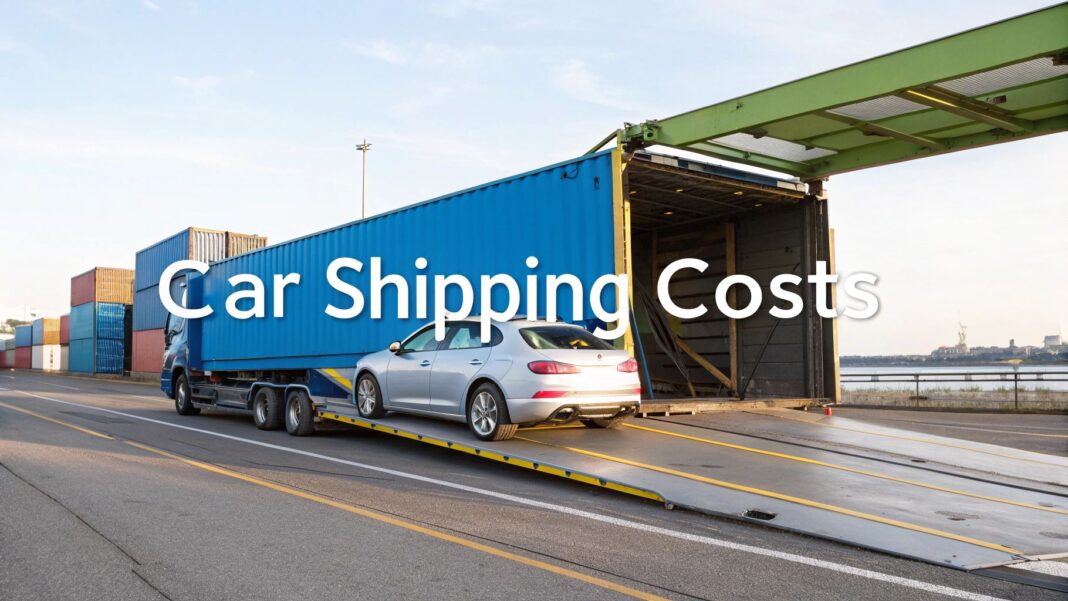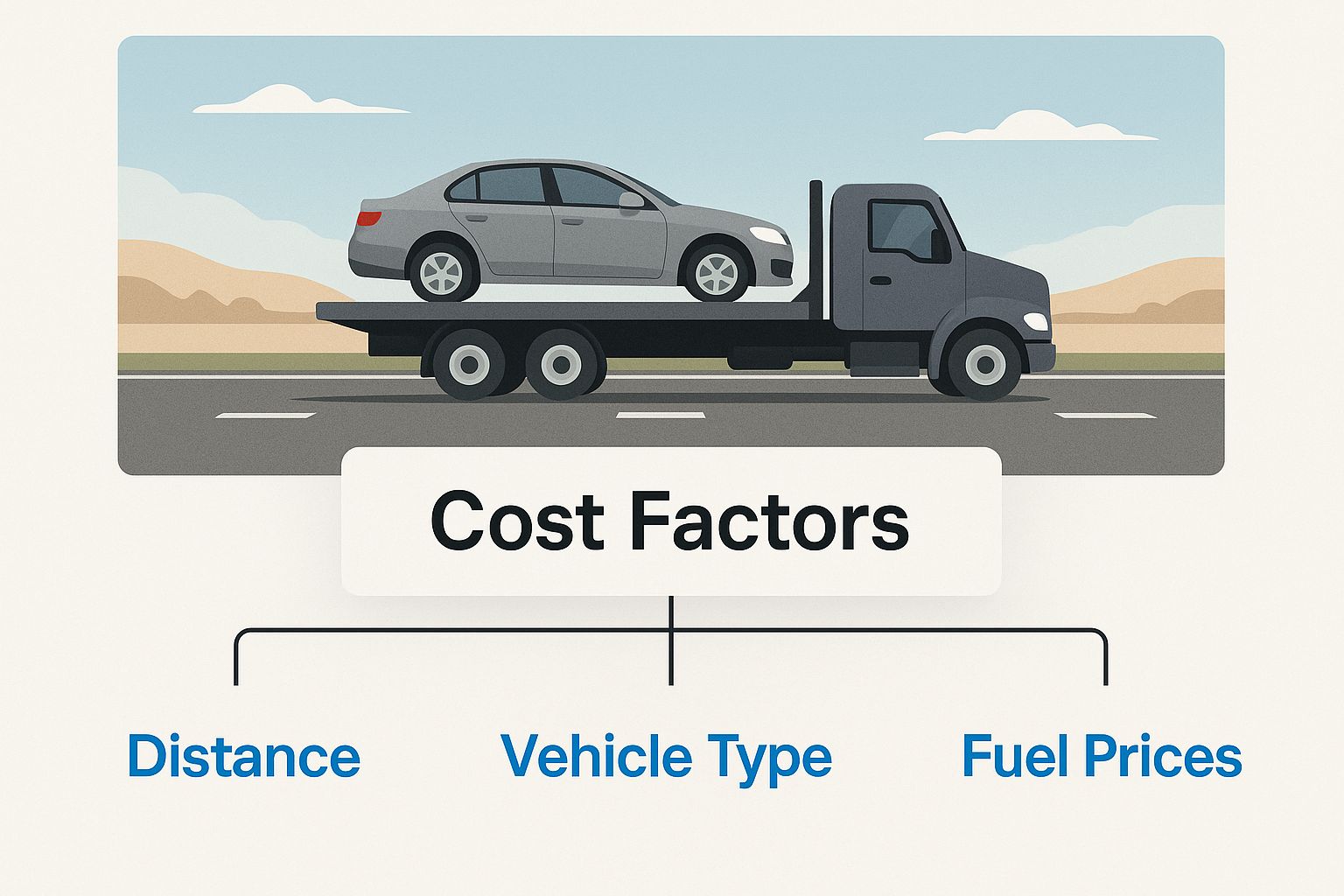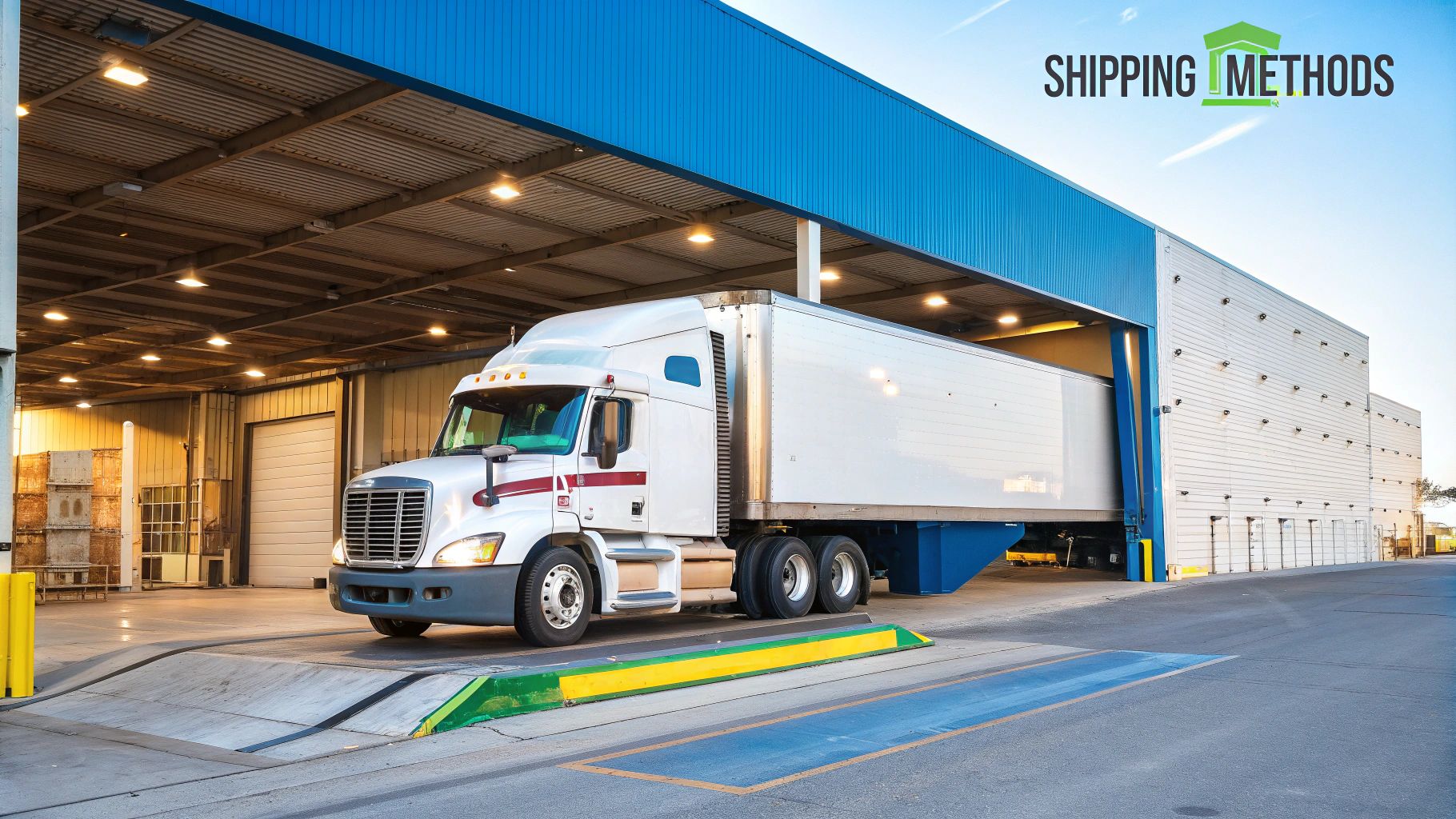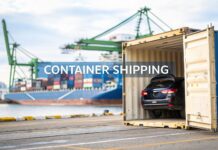
What's the real cost to ship a car? On average, expect to pay between $0.60 to $2.60 per mile. However, the final price is heavily influenced by the total distance of the journey.
A key principle to remember is that while longer trips have a higher total cost, the rate you pay per mile actually decreases. Shorter trips, conversely, have a higher per-mile cost. Understanding this and other core factors will empower you to find the best possible rate.
Decoding Your Car Shipping Quote
Receiving a car shipping quote can feel opaque. You see the final number, but the calculation behind it isn't always clear. Your final cost is a blend of several key variables, including the transport distance, the size of your vehicle, and the type of carrier you choose.
Let's break down each component. This will not only clarify where your money is going but also reveal actionable strategies for reducing your overall expense.
A Look at Average Prices
The most significant factor in your quote is almost always distance. The farther your vehicle needs to travel, the higher the total bill, but the lower your cost-per-mile will be. These rates are also directly tied to real-world operational costs for the carrier, such as the current price of diesel fuel.
Here’s a practical breakdown of what to expect based on mileage:
- Short Hauls (0-500 miles): For local or regional transport, the rate is typically between $1.60 and $2.60 per mile.
- Medium Trips (501-1,500 miles): As the distance increases, the per-mile rate becomes more efficient, usually landing between $0.85 and $1.25 per mile.
- Cross-Country (over 1,501 miles): On the longest journeys, you benefit from the best economy of scale, with rates generally ranging from $0.60 to $0.95 per mile.
This might seem counterintuitive, but the math is straightforward. A 500-mile trip might cost $800 ($1.60 per mile), while a 2,500-mile cross-country trip could be around $1,750 ($0.70 per mile). The total is higher, but the value per mile is significantly better.
Average Car Shipping Cost Per Mile by Distance
This table offers a clear estimate of the cost-per-mile for shipping a standard sedan. Use it as a tool for initial budgeting and to understand how distance impacts your rate.
| Distance Range (Miles) | Average Cost Per Mile (Open Carrier) | Estimated Total Cost Example (1000 miles) |
|---|---|---|
| Under 500 Miles | $1.95 | ~$780 for 400 miles |
| 501 – 1,500 Miles | $1.05 | ~$1,050 for 1,000 miles |
| Over 1,501 Miles | $0.80 | ~$2,000 for 2,500 miles |
While these figures provide a solid baseline, every shipment has unique variables. The most effective way to determine your exact cost is to get a quote based on your specific details.
For a precise, no-obligation estimate, using an online tool is the best course of action. You can get a personalized quote in minutes with our vehicle shipping calculator and see exactly what your transport will cost.
The 7 Core Factors Driving Your Final Price
If you've ever requested multiple quotes and seen different prices, you've witnessed the core pricing factors in action. The final cost of your auto transport isn't arbitrary; it's a calculated result based on specific logistical and market-driven variables.
Understanding these factors gives you control. You can make informed decisions that directly influence your final bill. This breakdown explains exactly what goes into that final number.

As illustrated, factors like distance have the largest impact, but each element contributes to the total cost.
1. Distance and Location
The mileage from pickup to delivery is the primary cost driver. As we've noted, longer trips cost more in total but less per mile.
However, the specific route is just as critical. Shipping a car along a high-traffic interstate, like from Los Angeles to Dallas, is typically more affordable than transporting it to a remote town. Carriers prefer major routes because they can fill their trucks faster, which increases efficiency and lowers the cost for everyone on that load.
2. Vehicle Size and Weight
Auto transport trailers are subject to strict Department of Transportation regulations regarding weight and space. Your vehicle's dimensions and mass directly impact the carrier's capacity.
- Bigger Vehicles: A large SUV or pickup truck can occupy the space of two smaller sedans. To compensate for this lost revenue, the carrier must charge more for the larger vehicle.
- Heavier Vehicles: A heavier car increases the truck's fuel consumption. It also consumes a larger portion of the trailer's maximum weight allowance, and this is factored into your price.
3. Open vs. Enclosed Transport
This choice is one of the most significant cost decisions you will make.
Open transport is the most common and cost-effective method. Your vehicle is transported on an open-air trailer, similar to how new cars are delivered to dealerships. Enclosed transport offers complete protection from weather and road debris inside a sealed trailer. This premium service typically costs 30-60% more but provides maximum security for high-value vehicles.
4. Vehicle Condition
The operational status of your car matters. A vehicle that can be driven onto the trailer is simple and quick to load.
If your car is inoperable—meaning it cannot start, steer, or brake on its own—the process becomes more labor-intensive. The driver must use special equipment, like a winch, to carefully load the vehicle. This additional work and equipment will result in an extra fee, usually between $100 and $200.
5. Seasonal Demand
The auto transport industry experiences predictable peak seasons that drive up prices.
- Peak Season (Summer Months): Summer is the most popular time for moving in the U.S. This surge in demand for all types of shipping, including vehicles, increases carrier rates.
- Snowbird Season (Late Fall/Early Spring): During these periods, there is a massive migration of vehicles to and from warmer states like Florida, Arizona, and Texas. This creates high demand and higher prices along these specific north-south routes.
6. Fuel Prices
Fuel is a major and fluctuating expense for any trucking operation. When diesel prices rise, carriers must adjust their rates to remain profitable, often by applying a fuel surcharge. This is a dynamic factor that can cause quotes to change from one week to the next.
7. Pickup and Drop-Off Accessibility
The accessibility of your location is a practical consideration. A standard 75-foot auto carrier cannot navigate narrow residential streets or remote rural roads.
If your location is inaccessible, the driver will coordinate with you to meet at a safe and convenient nearby location, such as a large parking lot. While door-to-door service is the standard, difficult locations may incur a small fee for the additional logistical planning required.
Why Do Luxury Cars and EVs Cost More to Ship?
When it comes to your car shipping cost, the type of vehicle matters immensely. A standard sedan is a straightforward transport, but shipping a high-value luxury car or a heavy Electric Vehicle (EV) requires specialized handling and resources, which is reflected in the price. It's not just about the vehicle's price tag; it's about the specific logistical needs to ensure its safe transit.
Think of it as insuring a valuable asset. Owners of specialty vehicles opt for a higher level of service to protect their investment, and this service comes at a premium.

The Premium for Protection and Weight
For luxury, classic, and exotic cars, the primary goal is protection. The most effective method is enclosed transport, which shields the vehicle from all weather, road debris, and potential security risks. This "white-glove" service is the main reason for the higher cost.
This premium service commands a 30% to 60% price increase over standard open transport. For instance, shipping a Porsche 911 from Miami to Los Angeles via an enclosed carrier could cost over $2,200, whereas a standard sedan on the same route might cost around $1,300 on an open carrier. You are paying for a secure, controlled environment.
To learn more about this specialized service, our guide on https://www.wewilltransportit.com/enclosed-vehicle-transport-services/ offers a detailed look at the process and its advantages.
For EVs, the key cost factor is weight.
The large lithium-ion battery packs make EVs like the Tesla Model S or Ford F-150 Lightning hundreds or even thousands of pounds heavier than their gasoline-powered counterparts. This extra weight increases fuel consumption and reduces the number of cars a carrier can legally transport in a single load, forcing them to charge more to compensate.
Cost Comparison: Open vs. Enclosed Transport
This table provides a clear comparison of how transport type affects the cost for different vehicles on a cross-country route.
| Vehicle Type | Route (Example) | Estimated Open Carrier Cost | Estimated Enclosed Carrier Cost | Price Difference (%) |
|---|---|---|---|---|
| Honda Accord | New York, NY to Los Angeles, CA | $1,250 | $1,800 | +44% |
| Tesla Model 3 | New York, NY to Los Angeles, CA | $1,400 | $2,000 | +43% |
| Porsche 911 | New York, NY to Los Angeles, CA | $1,350 | $2,250 | +67% |
| Ford F-150 | New York, NY to Los Angeles, CA | $1,500 | $2,100 | +40% |
The data shows a consistent premium for enclosed shipping, with the largest percentage increase often applied to high-performance cars that require the most delicate handling.
Specialized Handling Requirements
Beyond a protective covering, these vehicles demand specific equipment and driver expertise.
- Specialized Loading: Low-clearance vehicles like a Ferrari cannot be loaded using standard ramps without causing damage. They require carriers equipped with hydraulic lift gates for safe, level loading.
- Extra Insurance: A carrier's standard insurance policy might not cover the full value of a high-end vehicle. Transporting more expensive cars often requires the carrier to purchase additional insurance coverage, a cost that is factored into the quote.
- Driver Expertise: Entrusting a valuable asset to a carrier requires confidence in their professionalism. Companies specializing in high-end transport use experienced drivers trained in securing and handling luxury vehicles and complex EVs.
Furthermore, owners of valuable cars often utilize advanced car security systems for tracking. They expect a carrier who can accommodate this technology. The combined need for protection, weight compensation, and specialized handling explains the premium price—it's a fee for expertise and peace of mind.
How Market Trends Impact Your Shipping Quote
Your car shipping cost is not determined in a vacuum; it's directly influenced by broader economic trends. Factors like fluctuating fuel prices and shifts in the automotive market can affect carrier operating costs, and these changes are ultimately reflected in your quote.
Understanding these external forces will help you interpret your quote and make you a more knowledgeable consumer.

The Fuel Surcharge Wild Card
The most volatile external factor is the price of fuel. Diesel is a primary operating cost for auto carriers, and its price can change rapidly.
To manage this volatility, carriers often apply a fuel surcharge. This is not a hidden fee but a transparent adjustment that rises and falls with market fuel prices. It functions similarly to the variable energy charge on a utility bill.
A significant spike in diesel prices can add $50 to $150 or more to a cross-country shipment. This "wild card" reflects economic pressures that are entirely outside the carrier's control.
New Car Sales and Shifting Demand
It might seem logical that a decrease in new car sales would lower shipping demand and prices. However, the market is more complex. While new car sales have seen shifts, overall shipping demand remains strong, though its nature has changed.
The booming markets for used cars and EVs have created new shipping patterns. Instead of predictable, high-volume routes from manufacturing plants to dealerships, carriers are now handling more individual, one-off transports. This shift from bulk logistics to single-vehicle shipments creates a different and often more complex logistical landscape. You can discover more insights about car shipping patterns on tciships.com to see how these global trends are impacting the industry.
Ultimately, these macroeconomic trends mean that pricing is always dynamic. Being aware of them provides context for your quote and highlights its connection to the larger economy.
Practical Ways to Lower Your Car Shipping Cost
Understanding the factors that determine your car shipping cost is the first step. The next is to use that knowledge to actively reduce your expenses. By employing a few strategic approaches, you can lower your bill without sacrificing safe and reliable service.
Think of it like booking travel—the destination is fixed, but your choices about timing and service level can significantly alter the price.
Be Flexible With Your Timing
Flexibility is one of your most powerful negotiating tools. If you can provide the shipping company with a multi-day pickup window, you give them the ability to fit your vehicle into the most efficient and cost-effective route. This allows the carrier to fill an empty spot on a truck already scheduled to be in your area—a win for their logistics and a win for your wallet.
Conversely, requesting an urgent pickup within a narrow 24-hour timeframe will almost always cost more, as it requires the company to dispatch a specific driver on short notice.
Actionable Tip: Booking your shipment at least two to three weeks in advance can often save you $100 to $200. This lead time allows dispatchers to optimize their routes and find the most economical transport solution for your vehicle.
Compare Terminal-to-Terminal vs. Door-to-Door
The standard service model is door-to-door shipping, where the carrier picks up and delivers your vehicle as close to your specified addresses as is safely and legally possible. This offers maximum convenience but comes at a higher price.
A cost-effective alternative is terminal-to-terminal shipping. With this option, you drive your car to a designated regional hub and pick it up from a similar terminal near your destination. While it requires more effort on your part, it simplifies the logistics for the carrier, resulting in savings that are passed on to you.
Smart Preparation Saves Money
A few simple preparatory steps can prevent unexpected fees. The most important is to empty your car of all personal belongings. Carriers are not licensed or insured to transport household goods, and any items left inside are not covered against loss or damage.
Additionally, extra items add weight. Every truck operates under strict weight limits, and an overloaded vehicle can incur penalties. Remove all personal effects, leaving only standard vehicle equipment like a spare tire and jack. Finally, ensure your gas tank is only about a quarter full—enough for loading and unloading but not so much that it adds significant excess weight.
These tips are a solid foundation. For more ideas, explore these strategies for affordable long-distance moving. For an even more focused guide, our article on finding cheap car shipping provides additional insights into securing the best rate.
A Few Final Questions About Car Shipping Costs
After covering the major cost factors, some practical questions often remain. Here are clear, actionable answers to the most common inquiries, helping you finalize your transport plans with confidence.
Is My Vehicle Fully Covered by the Carrier's Insurance?
While all federally licensed carriers must carry cargo insurance, it's crucial to understand the specifics of their coverage. The policy covers damage to the vehicle itself, but it has limits.
Crucially, personal items left inside the car are almost never covered by the carrier's insurance.
Actionable Tip: Before booking, request a copy of the carrier's Certificate of Insurance. This document details their coverage limits and any applicable deductibles. It's also wise to contact your personal auto insurance provider, as some policies offer coverage for your vehicle while it is in transit.
How Long Will It Actually Take to Ship My Car?
The delivery timeline is primarily determined by distance.
A cross-country transport, such as from California to New York, typically takes 7 to 10 days. Shorter, regional moves are much quicker, often completed in just 2 to 4 days.
Remember that all timelines are estimates. Unforeseen delays from weather, traffic, or other logistical issues can occur. For this reason, your shipper will provide a delivery window rather than a guaranteed date.
Insider Tip: The "first available pickup date" does not always guarantee the fastest delivery. A driver may pick up your car and then spend another day or two collecting other vehicles in the region before starting the long-haul journey.
Can I Load Up My Car with Personal Stuff?
The answer is almost always no. Most carriers strictly prohibit the transport of personal belongings in a vehicle for several important reasons.
First, their license and insurance are for transporting vehicles, not household goods. Their cargo insurance will not cover loss or damage to your personal items. If you pack valuables in the trunk and they go missing, you will have no recourse with the carrier.
Second, every extra pound matters. Added weight can result in overweight fees and potential safety violations with the Department of Transportation (DOT). The best practice is to ship your car empty, containing only standard vehicle equipment (spare tire, jack, emergency kit). This ensures a smooth, fee-free transport.
Ready to get a clear, no-nonsense quote for your vehicle transport? The experts at We Will Transport It are here to manage every detail, ensuring your car arrives safely and on schedule. Get your free, personalized estimate today by visiting https://www.wewilltransportit.com.





